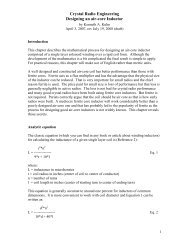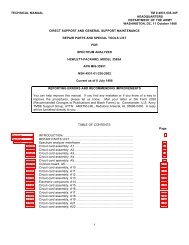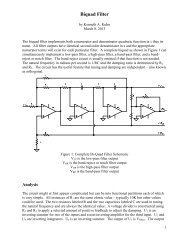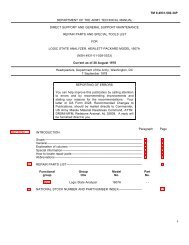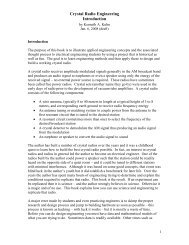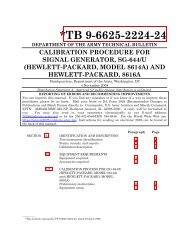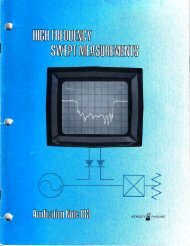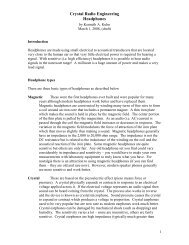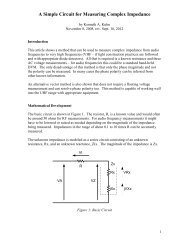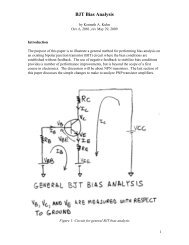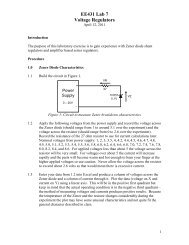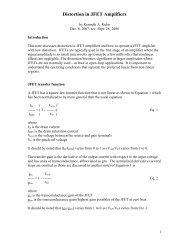How to Design an Enclosure for low Radio Frequency ... - Ken Kuhn's
How to Design an Enclosure for low Radio Frequency ... - Ken Kuhn's
How to Design an Enclosure for low Radio Frequency ... - Ken Kuhn's
Create successful ePaper yourself
Turn your PDF publications into a flip-book with our unique Google optimized e-Paper software.
<strong>How</strong> <strong>to</strong> <strong>Design</strong> <strong>an</strong> <strong>Enclosure</strong> <strong>for</strong> <strong>low</strong><strong>Radio</strong> <strong>Frequency</strong> Emissions <strong>an</strong>d Susceptibilityby <strong>Ken</strong>neth A. KuhnMarch 16, 2003, revised June 2, 2008OverviewThis note discusses the essentials of enclosure design <strong>for</strong> electronic equipment <strong>an</strong>dconnection design <strong>to</strong> that equipment <strong>to</strong> minimize emitted radio frequency (RF) energy<strong>an</strong>d <strong>to</strong> also minimize susceptibility of that equipment <strong>to</strong> external radio frequency fieldsfrom nearby tr<strong>an</strong>smitters such as walkie-talkies. These two issues (known aselectromagnetic compatibility or EMC) are interrelated <strong>an</strong>d have the identical solution.Whatever is done <strong>to</strong> address one problem also addresses the other. This note is dividedin<strong>to</strong> two parts, enclosure design <strong>an</strong>d connec<strong>to</strong>r/cable design. All that is required <strong>for</strong>successful enclosure design is the underst<strong>an</strong>ding <strong>an</strong>d application of the basicfundamentals.The Fundamentals<strong>Radio</strong> frequency energy will not enter or exit a fully enclosed conductive enclosure (i.e.metal) provided that1. The thickness of the conduc<strong>to</strong>r exceeds about three the skin depths. Thisrequirement is easily met by practical enclosure thicknesses used unless thefrequency of interest is very <strong>low</strong> (much less th<strong>an</strong> 100 kHz).2. That there are no conductive discontinuities in <strong>an</strong>y direction around theenclosure (i.e. there c<strong>an</strong> be no junctions of enclosure parts, windows, ventilationholes, etc.–the enclosure must be a continuous solid.).3. That there are no external cables bringing signals in<strong>to</strong> or out of theenclosure. Unless implemented properly, cables become <strong>an</strong>tennas that c<strong>an</strong> coupleRF energy in<strong>to</strong> or out of <strong>an</strong> otherwise perfect enclosure. This includes the ACline cord or external power cables.Obviously, a practical enclosure c<strong>an</strong> not meet the above requirements as stated.<strong>How</strong>ever, there are m<strong>an</strong>y clever methods that c<strong>an</strong> be applied <strong>to</strong> practical enclosure designso that all requirements are effectively met. The requirements do not have <strong>to</strong> be perfectlymet–all one has <strong>to</strong> do is get close enough. These methods are described in the nextsection.1
<strong>Enclosure</strong> <strong>Design</strong><strong>How</strong> <strong>to</strong> <strong>Design</strong> <strong>an</strong> <strong>Enclosure</strong> <strong>for</strong> <strong>low</strong><strong>Radio</strong> <strong>Frequency</strong> Emissions <strong>an</strong>d SusceptibilityThe shielding effectiveness of <strong>an</strong> enclosure is a function of how uni<strong>for</strong>m the highfrequency conductivity is in <strong>an</strong>y direction around the surface of the enclosure. Anydiscontinuity or gradient in this conductivity causes non-uni<strong>for</strong>mity in the surface currentsinduced by RF fields thus <strong>for</strong>ming a surface <strong>an</strong>tenna which c<strong>an</strong> couple RF energy in<strong>to</strong> orout of the enclosure. Surface <strong>an</strong>tennas represent <strong>an</strong> undesirable tr<strong>an</strong>sparency of theenclosure <strong>to</strong> RF. Although high conductivity is desirable, it is more import<strong>an</strong>t <strong>for</strong> theconductivity <strong>to</strong> be uni<strong>for</strong>m in all directions. For example, although steel is much lessconductive th<strong>an</strong> aluminum, a solid steel enclosure with uni<strong>for</strong>m conductivity all around issuperior at RF <strong>to</strong> a multipiece aluminum enclosure with gradations in conductivity atmetallic junctions. As a simplistic example, imagine that you are <strong>an</strong> electron that istraveling <strong>an</strong>y circumference of the enclosure. Any path you take that requires a de<strong>to</strong>urfrom direct represents a discontinuity that c<strong>an</strong> <strong>for</strong>m <strong>an</strong> undesired <strong>an</strong>tenna. The goal ofenclosure design is <strong>to</strong> minimize the effect of necessary obstacles. De<strong>to</strong>urs should be nomore th<strong>an</strong> about five percent of a wavelength at the highest frequency of interest (this isabout half <strong>an</strong> inch <strong>for</strong> a 1 GHz upper limit).Some physical discontinuities are a necessity <strong>for</strong> a practical enclosure–<strong>an</strong>y enclosure isgenerally going <strong>to</strong> be at least two assembled pieces, there has <strong>to</strong> be holes <strong>for</strong> electricalconnec<strong>to</strong>rs, ventilation holes may be needed, or some sort of optical window may beneeded, etc. With careful design, these issues c<strong>an</strong> be resolved with minimum effect onthe RF integrity of the enclosure.Mating surfaces: Where different surfaces of the enclosure meet there must not be <strong>an</strong>ypaint or other coating that would inhibit conductivity between them. A painted surfaceagainst a painted surface is a barn door wide open <strong>for</strong> RF. Even bare metal against baremetal is very poor as most of the contact area is actually air gap–however small. Somecoatings may be added <strong>to</strong> enh<strong>an</strong>ce conductivity. It is very import<strong>an</strong>t that differentsurfaces mate under pressure. A very bad situation is <strong>an</strong> edge meeting <strong>an</strong> edge as there isno way <strong>to</strong> seal this. The best situation is where there is sufficient overlap of the differentpieces so that <strong>an</strong> RF gasket c<strong>an</strong> be installed. An RF gasket fills imperfections where twosurfaces meet thus insuring a continuum of conduction <strong>to</strong> prevent open spots which <strong>for</strong>m<strong>an</strong>tennas. Two pieces of metal may visually appear <strong>to</strong> mate very well but that is notsufficient. Some sort of RF gasket must also be used <strong>to</strong> prevent conductivity gradientsbetween the two pieces. Mech<strong>an</strong>ical <strong>for</strong>ce must exist on all parts of the gasket <strong>for</strong> it <strong>to</strong> doits job. Think of it this way–if the bare metal mating surfaces would not <strong>for</strong>m a crudepneumatic seal then they will not <strong>for</strong>m <strong>an</strong> RF seal either. In both cases the appropriatetype of gasket is needed. In the case of RF, energy does not enter or exit via the minutegap but is radiated through the metal via the <strong>an</strong>tenna <strong>for</strong>med by the gap. As <strong>an</strong> example,consider sitting in a fine parked car with all the windows tightly raised. Outside noisebarely gets through. Now crack open a window by a tiny amount <strong>an</strong>d note how much theoutside noise increases. This example illustrates the import<strong>an</strong>ce of sealing all matingsurfaces. Any surface not sealed is a gaping hole.2
<strong>How</strong> <strong>to</strong> <strong>Design</strong> <strong>an</strong> <strong>Enclosure</strong> <strong>for</strong> <strong>low</strong><strong>Radio</strong> <strong>Frequency</strong> Emissions <strong>an</strong>d SusceptibilityScrews: Liberal use of screws should be incorporated <strong>to</strong> maintain close pressure pointson the RF gasket so that gradients in conductivity between the two pieces are minimized.Ideally, the spacing of the screws should be no more th<strong>an</strong> about ten percent of awavelength at the highest frequency of interest (about 1.25 inches <strong>for</strong> a 1 GHz upperlimit). This may result in <strong>an</strong> exorbit<strong>an</strong>t number of screws. The spacing c<strong>an</strong> be increasedif the two pieces have little flex–the issue is how much <strong>low</strong>er the pressure is on thegasket material half way between the screws. Low pressure on the gasket material willreduce conductivity <strong>an</strong>d <strong>an</strong>tennas may be <strong>for</strong>med. With stiff surfaces <strong>an</strong>d good RF gasketmaterial, a screw spacing of two inches will probably be fine <strong>for</strong> a 1 GHz upper limit–three <strong>to</strong> five inches might be the extreme be<strong>for</strong>e problems become serious. The import<strong>an</strong>tissue is sufficient pressure on the RF gasket–<strong>an</strong>y method that accomplishes thatregardless of the number of screws or spacing will work. Once the limit is reached ofwhat will work, RF problems increase very rapidly <strong>for</strong> small excursions over the limit.Ventilation Holes: The ideal hole <strong>for</strong> ventilation is <strong>an</strong> array of small round holes–eachhole diameter should be no more th<strong>an</strong> about one percent of a wavelength at the highestfrequency of interest (about 0.1 inch <strong>for</strong> a 1 GHz upper limit). Center <strong>to</strong> center-centerhole spacing should be no closer th<strong>an</strong> about 1.5 hole diameters so that there is sufficientmetal <strong>for</strong> conduction. Slots c<strong>an</strong> be used provided the slot width is not more th<strong>an</strong> abou<strong>to</strong>ne percent <strong>an</strong>d the slot length is not more th<strong>an</strong> about five percent of a wavelength at thehighest frequency of interest. If longer slots are needed then break them up in<strong>to</strong> a seriesof shorter slots. Although this array would appear <strong>to</strong> be tr<strong>an</strong>sparent <strong>to</strong> RF (it is obviouslytr<strong>an</strong>sparent <strong>to</strong> light) in actuality it is opaque if done right. As <strong>an</strong> example, observe thefine array of holes <strong>for</strong>ming the door window in a microwave oven. You c<strong>an</strong> easily seethrough that but the door is <strong>to</strong>tally opaque <strong>to</strong> the 2.45 GHz RF inside.For <strong>for</strong>ced ventilation, a metal f<strong>an</strong> screen should be used <strong>for</strong> the opening. There are <strong>an</strong>umber of aluminum mesh screens made just <strong>for</strong> this purpose. It is very import<strong>an</strong>t thatthe metal screen have good contact <strong>to</strong> the enclosure on all sides. Attachment at the fourscrews in the corners is not enough–some kind of gasket is needed around thecircumference–otherwise <strong>an</strong> <strong>an</strong>tenna may be <strong>for</strong>med. A common error is <strong>to</strong> place thescreen over a painted surface.Optical Windows: There are two methods <strong>to</strong> address this problem. One methodinvolves using a flat metal screen such that optical effects are minimal–but there willalways be some loss <strong>an</strong>d refraction effects may reduce resolution. M<strong>an</strong>ufacturers that sellRF gasket materials frequently have some kind of optical screen in their offerings. It isvery import<strong>an</strong>t that the screen contact the enclosure completely on all edges. Analternative is a thin metallic coating on a glass or plastic plate mounted such that themetallic coating contacts all edges of the enclosure surface. This coating will have <strong>an</strong>optical loss of perhaps fifty percent or more but generally causes minimal reduction inoptical resolution. The problem with both of these solutions is that there is <strong>an</strong>unavoidable gradient <strong>for</strong> RF energy that should freely circulate around the enclosure.Each approach is far better th<strong>an</strong> nothing. When possible, the ideal solution <strong>for</strong> thissituation is <strong>for</strong> the optical stuff <strong>to</strong> be mounted in a cavity such that all sides except <strong>for</strong> the3
<strong>How</strong> <strong>to</strong> <strong>Design</strong> <strong>an</strong> <strong>Enclosure</strong> <strong>for</strong> <strong>low</strong><strong>Radio</strong> <strong>Frequency</strong> Emissions <strong>an</strong>d Susceptibilityoptical path are continuous with the enclosure with only electrical feed throughs <strong>to</strong> accessthe optical tr<strong>an</strong>sducer.Copper tape: Copper tape c<strong>an</strong> be used <strong>to</strong> provide RF sealing where two surfaces meet<strong>an</strong>d <strong>an</strong> RF gasket is not practical. The disadv<strong>an</strong>tage is that the tape must be removed <strong>to</strong>separate the surfaces <strong>an</strong>d tears <strong>an</strong>d adhesive gaps will ultimately impair per<strong>for</strong>m<strong>an</strong>ceunless fresh tape is applied afterwards. This solution may be fine if the two surfaces willeither never or only rarely be separated. Copper tape is great <strong>for</strong> experimental purposes<strong>to</strong> solve RF sealing problems in a pro<strong>to</strong>type enclosure. Copper tape will do nothing ifinstalled on a painted or insulated surface. Do not make the error of using commonlyavailable aluminum tape intended <strong>for</strong> taping metal ductwork. Because the adhesive is <strong>an</strong>insula<strong>to</strong>r, this stuff is absolutely useless <strong>for</strong> RF work. The adhesive on copper tape made<strong>for</strong> RF work is conductive. Copper tape is not a substitute <strong>for</strong> a good RF gasket <strong>an</strong>d theRF per<strong>for</strong>m<strong>an</strong>ce of a copper taped system c<strong>an</strong> never be as good as when <strong>an</strong> RF gasket isproperly used.Commercial <strong>Enclosure</strong>s: There are a variety of metallic commercial enclosures made<strong>for</strong> pro<strong>to</strong>typing or small production runs. Most of these have poor <strong>to</strong> awful RFper<strong>for</strong>m<strong>an</strong>ce. One common small enclosure consists of two U-shaped folded aluminumboxes that would appear <strong>to</strong> be excellent <strong>for</strong> RF as they completely close. But note thatthe surfaces <strong>to</strong> not mate under pressure (except at widely spaced screw points) <strong>an</strong>d thatthere are edge <strong>to</strong> edge junctions. Thus, this enclosure is poor. Another common type ofenclosure consists of a cast aluminum tub with a cast lid. It would seem that this wouldmake <strong>an</strong> RF tight enclosure when the lid is screwed down. Wrong! The pressure pointson the lid screws are <strong>to</strong>o widely spaced. If <strong>an</strong> RF gasket is used between the lid <strong>an</strong>d thetub then this enclosure c<strong>an</strong> work well. Full-sized enclosures <strong>for</strong> rack mount or instrumentdesk <strong>to</strong>p applications look very nice but have so m<strong>an</strong>y RF holes that it is virtuallyimpossible <strong>to</strong> seal them. Unless the enclosure is specifically designed <strong>to</strong> be RF tight (youwill pay a premium price <strong>for</strong> this) then expect it <strong>to</strong> be wide open <strong>for</strong> RF.<strong>Enclosure</strong> <strong>Design</strong> conceptsStrive <strong>for</strong> the minimum <strong>to</strong>tal length of RF sealing. <strong>How</strong>ever, this should not be the soledriver. Convenience of access is import<strong>an</strong>t <strong>to</strong>o. The object is <strong>to</strong> find bal<strong>an</strong>ce betweenconflicting needs. Clever engineering may simult<strong>an</strong>eously accomplish conflicting needswithout compromise. The fol<strong>low</strong>ing are brief descriptions of some concepts that c<strong>an</strong>work <strong>an</strong>d are provided as starting points <strong>for</strong> possible design.Four sided case with rear: One concept that works well is <strong>for</strong> the instrument <strong>to</strong> beconstructed on <strong>an</strong> inner framework <strong>an</strong>d the enclosure consists of a <strong>for</strong>med tub that slidesover the frame from the back <strong>an</strong>d RF seals against the rear of the front p<strong>an</strong>el. Except <strong>for</strong><strong>an</strong>y front p<strong>an</strong>el connections, all external electrical connections are made through a rearcut-out in the enclosure <strong>an</strong>d directly <strong>to</strong> a rear p<strong>an</strong>el that has a gasket seal with screws <strong>to</strong>the outer enclosure. The enclosure may have various small holes or slots <strong>for</strong> ventilationbut no internal device mounts <strong>to</strong> the enclosure. This design is remarkably simple <strong>an</strong>d4
<strong>How</strong> <strong>to</strong> <strong>Design</strong> <strong>an</strong> <strong>Enclosure</strong> <strong>for</strong> <strong>low</strong><strong>Radio</strong> <strong>Frequency</strong> Emissions <strong>an</strong>d Susceptibilityworks well. Sliding the case off the rear enables access <strong>to</strong> all sides of the instrument <strong>for</strong>service. This concept generally involves the least length <strong>to</strong> be RF sealed. Thedisadv<strong>an</strong>tage of this approach is that it may be awkward <strong>to</strong> slide the case on <strong>an</strong>d off.Three sided case with rear: One possible issue with the preceding concept is that thefeet (<strong>for</strong> desk<strong>to</strong>p operation) have <strong>to</strong> mount <strong>to</strong> the case. That may not be desirable <strong>for</strong> aheavy system. One modification is <strong>for</strong> the case <strong>to</strong> not have a bot<strong>to</strong>m so that the feet c<strong>an</strong>mount directly <strong>to</strong> the internal framework. The bot<strong>to</strong>m portion of the framework thusmust be <strong>an</strong> RF seal. The three sided case then slides over the framework <strong>an</strong>d has <strong>to</strong> sealat the front as well as the bot<strong>to</strong>m. This concept requires more length <strong>to</strong> be RF sealed butmay be simpler <strong>to</strong> work with.Three sided case without rear: For this concept the chassis is constructed in a Ustructure with a direct front <strong>an</strong>d rear p<strong>an</strong>el <strong>an</strong>d with a solid bot<strong>to</strong>m p<strong>an</strong>el. The case is alsoa U structure that goes down on <strong>to</strong>p. This concept is simple but requires a long length <strong>to</strong>be RF sealed. Also, a signific<strong>an</strong>t number of screws are required around the length <strong>to</strong> besealed. In spite of the issues with RF sealing, this concept is popular because of easyaccess. The engineering trick is <strong>to</strong> find ways <strong>to</strong> minimize the number of screws <strong>an</strong>d yetmaintain the necessary pressure on the RF gasket.Connec<strong>to</strong>r/cable <strong>Design</strong>Electrical feed through connections in<strong>to</strong> or out of <strong>an</strong> enclosure <strong>for</strong>m a path <strong>for</strong> conductedRF emissions <strong>an</strong>d susceptibility–i.e. external cables are <strong>an</strong>tennas. Improper use ofconnec<strong>to</strong>rs c<strong>an</strong> render a perfect RF enclosure useless. For this RF discussion, electricalconnections c<strong>an</strong> be divided in<strong>to</strong> two types–those <strong>for</strong> which there is no intent <strong>to</strong> conducthigh frequency <strong>an</strong>d those that are intended <strong>to</strong> conduct high frequency. Each type has <strong>to</strong>be addressed differently.Medium <strong>an</strong>d Low <strong>Frequency</strong> Connections Including DCThe worst conducted RF problems generally occur with connections that are intended <strong>for</strong>use at very <strong>low</strong> frequencies–perhaps DC or the AC line cord. The error is <strong>to</strong> assume thatGHz design practices are not needed <strong>for</strong> a <strong>low</strong>-frequency signal. Wrong! GHz designpractice is required <strong>for</strong> all signals including power supply voltages. Ideally, all signalsincluding power supply voltages are in coax cable or multiconduc<strong>to</strong>r shielded cable. Thebest cable shielding is a combination of braid <strong>an</strong>d foil. Braid by itself <strong>for</strong>ms a windowroughly 5 <strong>to</strong> 15 percent of the area. Foil by itself tends <strong>to</strong> have problems at highfrequencies. One of the worst ways <strong>to</strong> make connections in<strong>to</strong> or out of <strong>an</strong> enclosure iswith plastic shell connec<strong>to</strong>rs. It is impossible <strong>to</strong> seal these <strong>to</strong> RF. The portion of theconduc<strong>to</strong>rs inside the enclosure may act as <strong>an</strong>tennas <strong>to</strong> couple the inside of the enclosure<strong>to</strong> the outside.The solution is <strong>to</strong> make every conduc<strong>to</strong>r be at the same RF potential as the enclosure.This is accomplished by using physically small capaci<strong>to</strong>rs connected with very <strong>low</strong>5
<strong>How</strong> <strong>to</strong> <strong>Design</strong> <strong>an</strong> <strong>Enclosure</strong> <strong>for</strong> <strong>low</strong><strong>Radio</strong> <strong>Frequency</strong> Emissions <strong>an</strong>d Susceptibilityinduct<strong>an</strong>ce between every signal pin <strong>an</strong>d the enclosure. The series reson<strong>an</strong>ce of thisconnection must exceed the highest frequency of interest (typically 1 GHz). About theonly way this c<strong>an</strong> be accomplished is <strong>to</strong> purchase special connec<strong>to</strong>rs that have surfacemount capaci<strong>to</strong>rs attached between each signal pin <strong>an</strong>d the metal shell. The shell mustthen be attached <strong>to</strong> the enclosure (there must be no paint or insulation around the matingarea) using a small RF gasket. These connec<strong>to</strong>rs are known as filtered connec<strong>to</strong>rs <strong>an</strong>dcost signific<strong>an</strong>tly more th<strong>an</strong> st<strong>an</strong>dard connec<strong>to</strong>rs but are the easiest way <strong>to</strong> solve theproblem instead of treating symp<strong>to</strong>ms with st<strong>an</strong>dard connec<strong>to</strong>rs. The key <strong>to</strong> successfuloperation is <strong>for</strong> a complete distributed connection all around the connec<strong>to</strong>r shell. Pointgrounding is very poor at RF because of relatively high imped<strong>an</strong>ce.Various filtered connec<strong>to</strong>rs c<strong>an</strong> be used with signals up <strong>to</strong> a few MHz. At higherfrequencies, the capacit<strong>an</strong>ce of the connec<strong>to</strong>r will shunt the desired signal. For <strong>low</strong>frequency signals that use coaxial connec<strong>to</strong>rs such as BNC, filtered BNC connec<strong>to</strong>rs areavailable that shunts all high frequency signals <strong>to</strong> the ground or case. The specificationsof the filtered connec<strong>to</strong>r have <strong>to</strong> be checked <strong>to</strong> make sure that desired signals are notadversely affected.When there is a need <strong>for</strong> <strong>an</strong> array of coaxial signals, there are special D connec<strong>to</strong>rs withcoaxial inserts. These have been used <strong>for</strong> years <strong>to</strong> address this issue. This approach isgood <strong>for</strong> <strong>low</strong> or high frequencies.A particularly troublesome situation is when a ribbon cable must be used <strong>to</strong> conduct alarge number of signals in<strong>to</strong> or out of <strong>an</strong> enclosure. The problem is made worse when aplastic ribbon cable connec<strong>to</strong>r is used instead of a filtered connec<strong>to</strong>r. Bare ribbon cable isjust asking <strong>for</strong> trouble. The ribbon wires should be laid out as signal, ground, signal,ground, etc. <strong>to</strong> <strong>for</strong>m a <strong>low</strong>-imped<strong>an</strong>ce tr<strong>an</strong>smission line. The ribbon cable must beshielded. Consider as a minimum a metal foil shield around the ribbon cable with <strong>an</strong>excellent high frequency ground connection <strong>to</strong> the enclosure (<strong>an</strong>y pigtail wire on theshield <strong>to</strong> the enclosure should be very short). The best approach is <strong>to</strong> attach the ribbon <strong>to</strong>a metal shell connec<strong>to</strong>r (st<strong>an</strong>dard type - not filtered) <strong>an</strong>d use a solid metal shell (not metalplated plastic) <strong>an</strong>d roll the ribbon cable so that it c<strong>an</strong> slide inside of a large metal braid.The metal braid then attaches <strong>to</strong> the metal shell all around on the inside. The metal shellthen makes a good connection <strong>to</strong> the enclosure when it is bolted <strong>to</strong> the mating connec<strong>to</strong>r(a filtered type) attached <strong>to</strong> the enclosure. Pigtails should be avoided as they becomesignific<strong>an</strong>t induct<strong>an</strong>ces at UHF <strong>an</strong>d the shield then becomes <strong>an</strong> <strong>an</strong>tenna. A distributedground connection is always preferable <strong>to</strong> a point connection.When high frequency signals must be sent <strong>an</strong>d coax cable is not appropriate then thesignals must be differential. Differential signals have very <strong>low</strong> emission as the closeproximity of equal <strong>an</strong>d opposite fields c<strong>an</strong>cels <strong>for</strong> the most part although the c<strong>an</strong>cellationis usually far from perfect. Braid shielding is still needed as discussed earlier.Differential signals work best when each differential pair passes through a common modechoke <strong>to</strong> reduce <strong>an</strong>y common mode signal that would radiate. There are a number ofminiature surface mount filters made just <strong>for</strong> this application. Some will b<strong>an</strong>d limit the6
<strong>How</strong> <strong>to</strong> <strong>Design</strong> <strong>an</strong> <strong>Enclosure</strong> <strong>for</strong> <strong>low</strong><strong>Radio</strong> <strong>Frequency</strong> Emissions <strong>an</strong>d Susceptibilitydesired signal <strong>to</strong> just the b<strong>an</strong>dwidth needed (this reduces radiation of high frequencyharmonics).Ferrite clamps: For some types of problems, ferrite clamps around a wire or cable ofwires c<strong>an</strong> provide signific<strong>an</strong>t reduction in radiation or susceptibility. A ferrite clamparound a differential pair does not impede the differential signal but does impede <strong>an</strong>ycommon-mode signal. The troublesome signals are generally common-mode.Un<strong>for</strong>tunately, in m<strong>an</strong>y applications it is hard <strong>to</strong> tell if the ferrite did <strong>an</strong>ything. Ferrite is avery lossy material at high frequencies <strong>an</strong>d converts the wire it surrounds <strong>to</strong> a frequencydependent resis<strong>to</strong>r whose resist<strong>an</strong>ce increases with frequency. Inductive effects aregenerally negligible. It is not uncommon <strong>for</strong> a ferrite clamp <strong>to</strong> provide about 100 Ohmsof resist<strong>an</strong>ce at 100 MHz although this c<strong>an</strong> vary a lot depending on size. If the conduc<strong>to</strong>rhas a <strong>low</strong> RF imped<strong>an</strong>ce <strong>to</strong> the enclosure then a ferrite clamp mounted on the cable jus<strong>to</strong>utside the connec<strong>to</strong>r <strong>to</strong> the enclosure <strong>for</strong>ms a natural <strong>low</strong>-pass filter <strong>an</strong>d c<strong>an</strong> signific<strong>an</strong>tlyattenuate high frequency common-mode signals. If the conduc<strong>to</strong>r has a high RFimped<strong>an</strong>ce <strong>to</strong> the enclosure then the ferrite clamp will do little or nothing–even a longstring of clamps will do little.High <strong>Frequency</strong> ConnectionsHigh frequency connections should always be made via a coaxial connec<strong>to</strong>r whoseground has a very <strong>low</strong> imped<strong>an</strong>ce <strong>to</strong> the enclosure. Common connec<strong>to</strong>rs used includeBNC, N, <strong>an</strong>d SMA. BNC is generally inferior because it has no me<strong>an</strong>s <strong>to</strong> insure a <strong>low</strong>imped<strong>an</strong>ce ground connection–this problem gets worse as the connec<strong>to</strong>r ages–peoplesometimes wiggle a BNC connec<strong>to</strong>r searching <strong>for</strong> a sweet spot <strong>to</strong> <strong>low</strong>er the groundimped<strong>an</strong>ce. A faulty ground on a connec<strong>to</strong>r c<strong>an</strong> cause signal degradation, emission, <strong>an</strong>dsusceptibility problems. TNC is similar <strong>to</strong> BNC but solves this problem since theconnec<strong>to</strong>rs solidly screw <strong>to</strong>gether.Some Adv<strong>an</strong>ced TopicsSometimes things really go wrong. The enclosure may have been carefully designed <strong>for</strong><strong>low</strong> RF gradients <strong>an</strong>d filtered connec<strong>to</strong>rs have been exclusively used. But there is stilleither <strong>an</strong> emission or susceptibility problem. If the problem seems <strong>to</strong> be confined <strong>to</strong> justcertain b<strong>an</strong>ds of frequencies then it may be that the dimensions of the enclosure <strong>for</strong>m areson<strong>an</strong>t cavity that magnifies what would be weak RF coupling in a carefully designedenclosure. It is desirable <strong>to</strong> make the dimensions of the enclosure as small as possible sothat reson<strong>an</strong>t modes are pushed up in frequency. <strong>Enclosure</strong>s that are nearly square in alldimensions will have m<strong>an</strong>y active reson<strong>an</strong>t modes. <strong>Enclosure</strong>s that have one dimensionthat is very short in comparison <strong>to</strong> the other dimensions will generally have weak <strong>low</strong>erfrequency reson<strong>an</strong>t modes as the short spacing of the walls does not provide <strong>for</strong> goodlateral propagation of <strong>low</strong>er frequency modes that exist along the longer dimensions.This is known as a waveguide beyond cu<strong>to</strong>ff <strong>an</strong>d highly attenuates signal propagation.Computing the reson<strong>an</strong>t modes of <strong>an</strong> empty cavity is very straight<strong>for</strong>ward using thefol<strong>low</strong>ing equation.7
<strong>How</strong> <strong>to</strong> <strong>Design</strong> <strong>an</strong> <strong>Enclosure</strong> <strong>for</strong> <strong>low</strong><strong>Radio</strong> <strong>Frequency</strong> Emissions <strong>an</strong>d SusceptibilityF LMN = c * sqrt[ (L/2A) 2 + (M/2B) 2 + (N/2C) 2 ]whereF LMN = reson<strong>an</strong>t mode in Hz–<strong>an</strong> example might be F 101L, M, N = integer mode numbers (0, 1, 2, 3, etc.) only one of which c<strong>an</strong> be 0 at <strong>an</strong>y timec = speed of light (use 300,000,000 meters / second) (or 11.8E9 in. / sec.)A, B, C = dimensions of enclosure in same dist<strong>an</strong>ce units as c (use meters)The <strong>low</strong>est reson<strong>an</strong>t frequency of the enclosure is found by using the two largestdimensions in the above equation with 1 <strong>for</strong> the mode numbers. This reson<strong>an</strong>ce is weak(if signific<strong>an</strong>t at all) if the shortest (of the three) dimension is less th<strong>an</strong> a quarterwavelength (i.e. shortest dimension < 0.25*c / F) of the computed reson<strong>an</strong>ce (i.e., thecavity is operating in the waveguide beyond cu<strong>to</strong>ff mode). The <strong>low</strong>est strong reson<strong>an</strong>tfrequency is found by using the two smallest dimensions of the enclosure in the aboveequation with 1 <strong>for</strong> the mode numbers. For example, <strong>an</strong> empty 12” x 8” x 2” (A x B x C)enclosure has a first reson<strong>an</strong>ce, F 110 , at 887 MHz although this reson<strong>an</strong>ce is weak becauseof the 2” dimension. The <strong>low</strong>est strong reson<strong>an</strong>ce, F 011 , occurs at 1.65 GHz. Ideally, the<strong>low</strong>est strong reson<strong>an</strong>t frequency of the enclosure cavity should be much higher th<strong>an</strong> thehighest frequency of interest (frequently 1 GHz). Ideally (<strong>for</strong> RF suppression), theenclosure is long, narrow, <strong>an</strong>d thin.When the cavity contains lots of various objects then reson<strong>an</strong>ce calculation becomesimpossible. Signific<strong>an</strong>t metal surfaces within the cavity tend <strong>to</strong> raise the reson<strong>an</strong>tfrequency because smaller sub cavities are <strong>for</strong>med. That is good. Ideally, the sub cavitieswould be designed <strong>to</strong> increase the mode reson<strong>an</strong>ces beyond what might be a problem.Signific<strong>an</strong>t volumes of either a high permeable or high permitivity material tend <strong>to</strong> <strong>low</strong>erthe reson<strong>an</strong>t frequency because propagation through these materials is s<strong>low</strong>er. If lossy athigh RF, such materials may reduce EMI via absorption.Electronic issuesIt helps if the electronic circuits within the enclosure are laid out such that loop <strong>an</strong>tennasare not <strong>for</strong>med at high harmonics of the operating frequency.The power supply system should be designed as a tr<strong>an</strong>smission line <strong>an</strong>d should bedecoupled with high frequency capaci<strong>to</strong>rs spread over the entire board. One hazard inpower supply distribution is reson<strong>an</strong>ce caused by decoupling capaci<strong>to</strong>rs <strong>an</strong>d wiringinduct<strong>an</strong>ce. Reson<strong>an</strong>ce c<strong>an</strong> cause some select harmonic <strong>to</strong> be made much stronger–thisc<strong>an</strong> lead <strong>to</strong> emission problems or even r<strong>an</strong>dom logic error problems. Reson<strong>an</strong>ce is certain<strong>to</strong> occur somewhere–typically in the <strong>low</strong> tens of MHz. The best way <strong>to</strong> either preventpower supply reson<strong>an</strong>ce or fix it is <strong>to</strong> add small resist<strong>an</strong>ces in series with the powersupply voltage <strong>to</strong> small clusters of electronics with the bypass capaci<strong>to</strong>rs on the downstream side. These resis<strong>to</strong>rs damp <strong>an</strong>y reson<strong>an</strong>ce.8



